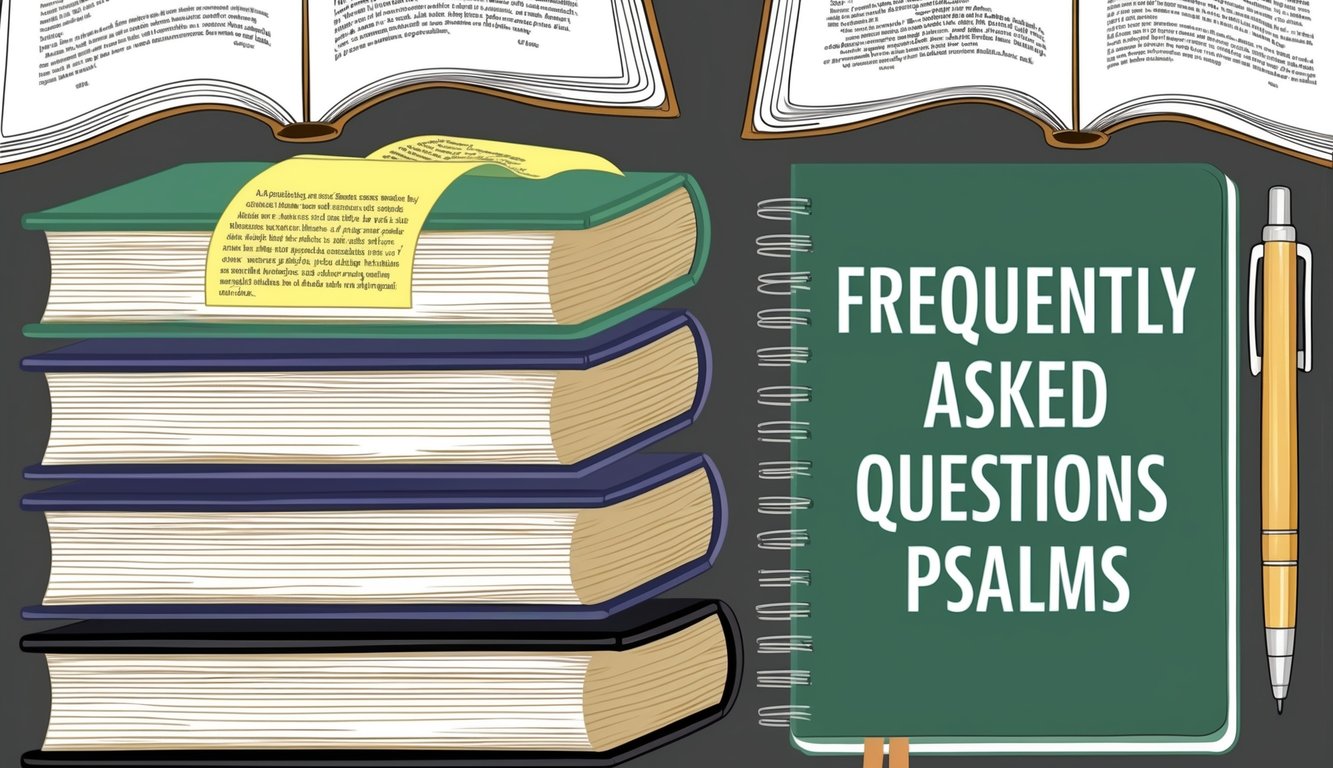Don’t Miss Out On This Unique Astrological Opportunity
Are you tired of spinning your wheels and getting nowhere? Simply put, you’re out of sync: you’re out of alignment with your astral configuration.
But: there’s a kind of map that can help you reclaim your alignment. Think of it as your own personal blueprint to success and happiness: a blueprint that will help you live your most amazing life.
Get started here.
The book of Psalms is a collection of lyrical songs and prayers found in the Old Testament.
It is one of the most widely read sections of the Bible, known for its poetic beauty and spiritual depth.
Psalms provide comfort, express sorrow, and offer praise, making them a vital tool for personal reflection and worship.
Understanding the origins and significance of the Psalms can enhance your appreciation for their timeless messages.
The Psalms are divided into five books, each addressing different themes like gratitude, lament, and worship.
Their structure allows them to serve as a guide for prayer and devotion.
The themes of the Psalms range from expressions of joy and thanksgiving to pleas for help and justice.
Their literary style and motifs provide insights into the human experience and our relationship with the divine.
For anyone seeking encouragement, the Psalms offer profound reflections that resonate across centuries.
Key Takeaways
- Psalms are poetic songs and prayers in the Bible.
- They deal with themes like gratitude, lament, and worship.
- Psalms provide insights into human experience and faith.
Origins and Significance of Psalms

The Psalms, a collection of religious songs and prayers, are found in the Old Testament.
These texts are historically rich and spiritually significant, influencing religious traditions and cultural practices for centuries.
Their origins span various authors and centuries, impacting how they are used in worship and religious studies.
Historical Context and Authorship
Psalms, also known by the Hebrew name Tehillim, are part of the Holy Bible.
Traditionally, David, son of Jesse, is credited with writing many of the Psalms.
Other contributors include Moses and Solomon, among others.
The Psalms existed in several forms before being compiled into Five Books.
These texts reflect various periods in Israelite history.
References to Elohim and Yahweh highlight different theological emphases.
The Greek Septuagint also includes adaptations of these Psalms, showing their influence beyond Hebrew tradition.
Each Psalm often begins with Superscriptions, providing context about authorship, usage, or musical direction.
Purpose and Liturgical Use
The primary purpose of the Psalms is worship and prayer.
They cover a range of themes, such as lament, thanksgiving, and praise.
In Jewish and Christian services, Psalms serve as part of the liturgical tradition, offering structure for worship and reflection.
The texts help express communal and personal spirituality.
Psalms function as both spoken prayers and chanted hymns.
They are part of daily prayers in Jewish tradition, enhancing their spiritual community’s life.
In Christian traditions, they are sung during mass and church services.
Psalms provide a link to ancient practices, maintaining a sense of continuity in modern worship.
Impact on Religion and Culture
The Psalms have greatly influenced religious thought and practices.
In Judaism and Christianity, they shape theological concepts and personal devotion.
The Psalms’ poetic nature offers depth in understanding human emotions and divine interaction.
Many phrases and themes have become embedded in cultural expressions and religious teachings.
The Psalms inspire art, literature, and music, showing their cultural reach.
Composers like Bach and Handel have composed music based on Psalms.
They also influence modern music and literary works.
These texts’ rich imagery and varied themes provide artists and writers fertile ground for exploration and expression.
Themes and Theological Elements

The Book of Psalms covers various themes and theological insights essential for spiritual life.
It offers a rich tapestry of ideas on righteousness, worship, and the relationship between individuals and God.
Emphasizing prayer and deliverance, it also explores hope and worship through poetic expressions.
Concepts of Righteousness and Wickedness
Psalms often contrast the righteous and wicked, highlighting the fate of the godly and sinners.
Righteous individuals delight in the law of the Lord and seek wisdom, while the wicked are compared to chaff blown away by the wind.
Judgment is a recurring theme, emphasizing that the wicked will perish, while the righteous are rewarded.
The covenant with God is central to understanding these themes.
Righteousness involves a heartfelt commitment to follow God’s commands.
The psalms advocate for a life aligned with God’s will, urging believers to make righteous choices and avoid the path of the wicked.
Expressions of Worship and Praise
Expressions of worship and praise are abundant in Psalms, positioning the texts as hymns and spiritual songs for the church and assembly.
They often include thanksgiving, highlighting God’s attributes and deeds.
Worship is not just a duty but a delight, where heartfelt praise becomes a pathway to divine connection.
In Psalms, worship involves more than words; it’s an expression of the spirit and heart.
Various psalms are structured to enhance the worship experience with joyful proclamations.
These expressions resonate through historical and modern contexts, fostering a strong, intimate relationship with God when believers gather to praise.
Prayer, Hope, and Deliverance
Prayers in Psalms often reflect a range of emotions from despair to hope.
Individuals pray for deliverance from enemies, seeking God’s intervention in troubling times.
The belief in God’s power to rescue and deliver is a central theme, providing solace and strength for the faithful.
Hope is a sustaining element, seen in prayers that trust in God’s future salvation.
These petitions often lead to confession and repentance, acknowledging human weaknesses.
Believers find hope in God’s steadfast love, turning to Him in times of trial to find peace and strength amid struggles.
Literary Structures and Motifs
Psalms feature a variety of literary structures and motifs that enrich their meaning and impact.
In this section, you will explore key elements such as imagery, musical influences, and structural techniques that define the Psalms.
Poetic Imagery and Symbolism
In the Psalms, imagery is vivid and connects deeply with human experience.
You often find references to trees, like a tree planted by streams of water, which symbolizes strength and stability.
The imagery of seasons and leaves highlights the cycles of life and growth.
Another powerful motif is the contrast between the paths of the blessed man and the wicked.
A tree that prospers near water represents the one who follows a righteous path, while dried leaves symbolize the fate of those who choose otherwise.
Symbolic language in the Psalms often emphasizes themes of faith and fierce battles.
The imagery of ropes or leashes signifies restraint or control, while the leviathan can symbolize chaotic forces.
These symbols connect spiritual lessons with natural and human elements.
Musical Elements and Instruments
Music plays a vital role in the Psalms, aiding memorization and enhancing worship.
Instruments like the harp, lyre, and lute feature heavily, along with the term Selah, which suggests a musical pause or reflection point.
Musical elements create a rhythm that mirrors the flow of streams of water or the rustling of leaves in the wind.
This rhythmic structure supports themes of praise and worship found in Royal Psalms and Psalms of Ascent.
The Psalms are often recited or sung during pilgrimage seasons, such as the journey to Jerusalem.
Instruments combined with poetic lines help convey the message of reverence and joy as you embark on these spiritual journeys.
Use of Parallelism and Acrostics
Parallelism is essential in Psalm structure, providing balance and emphasis.
Often, two lines reflect each other, reinforcing the message or contrasting opposing themes, such as blessings and curses or strength and weakness.
Acrostics organize the text alphabetically, offering a sense of completeness and artistry.
This style is evident in Psalm 119, structuring thoughts around each letter of the Hebrew alphabet.
It serves as a teaching tool and highlights the depth of devotion found in the Psalms.
Frequently Asked Questions

The Book of Psalms holds a special place in the Bible, offering insight into key spiritual themes and ancient poetic traditions.
This section addresses common inquiries about its significance, division, language, and its use by Jesus.
As a collection of songs and prayers, the Psalms reflect deep emotions ranging from praise and gratitude to lament and supplication.
Their behemoth Bible historical significance is evident in their influence on both Jewish and Christian worship, shaping liturgical practices for centuries.
Many of these passages were also quoted by Jesus, emphasizing their enduring spiritual importance.
What is the significance of Psalm 23 in the biblical context?
Psalm 23 is one of the most famous psalms, often known as “The Lord is my Shepherd.” It symbolizes God’s guidance, provision, and protection.
This psalm is frequently recited for comfort, emphasizing a personal relationship with God and assurance through life’s trials.
How is the Book of Psalms divided, and what are the themes of each section?
The Book of Psalms is divided into five books.
These divisions mirror the five books of the Torah and cover themes such as praise, lament, thanksgiving, and wisdom.
Each book ends with a doxology, celebrating God’s greatness and faithfulness.
What are the distinct features that characterize the language and poetry of Psalms?
The psalms are characterized by their poetic language, using parallelism and metaphor.
They express deep emotions and are designed for musical accompaniment.
This unique style helps convey complex human experiences and relationships with the divine.
In what ways did Jesus reference or use the Psalms according to the New Testament?
Jesus referenced the Psalms during his teachings and at important moments.
For instance, he quoted Psalm 22 on the cross.
These references illustrate the fulfillment of prophecy and stress the Psalms’ theological importance in understanding Jesus’s life and mission.
How does one pronounce ‘Psalms’ correctly in English?
The word “Psalms” is pronounced as “sahms.” The initial “P” is silent, and it rhymes with “calms” and “alms.” Understanding the correct pronunciation aids in confident reading and discussion.
What guidance or comfort is typically derived from Psalm 91?
Psalm 91 offers reassurance of God’s protection and refuge in times of danger.
It speaks of security under God’s care, encouraging trust and faith amidst life’s uncertainties.
This psalm is often invoked in prayer for its powerful promises of safety and deliverance.



